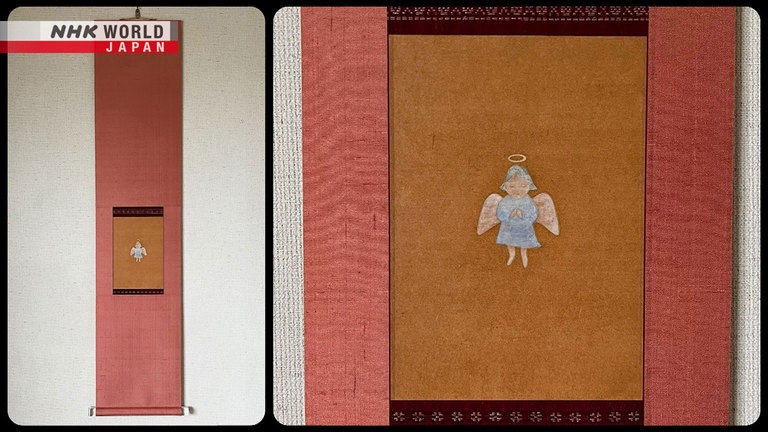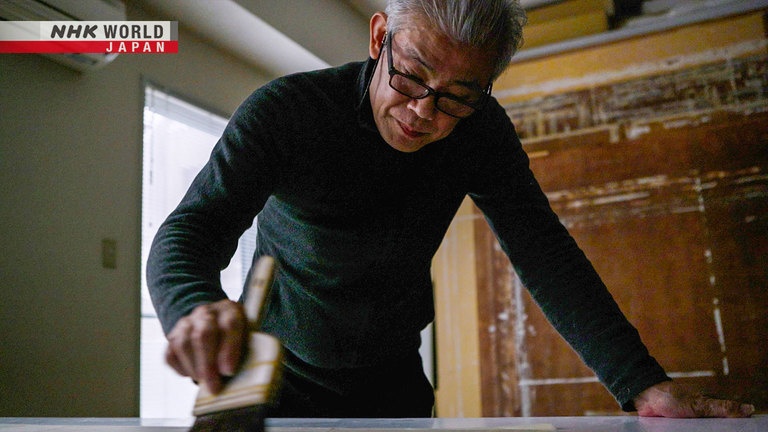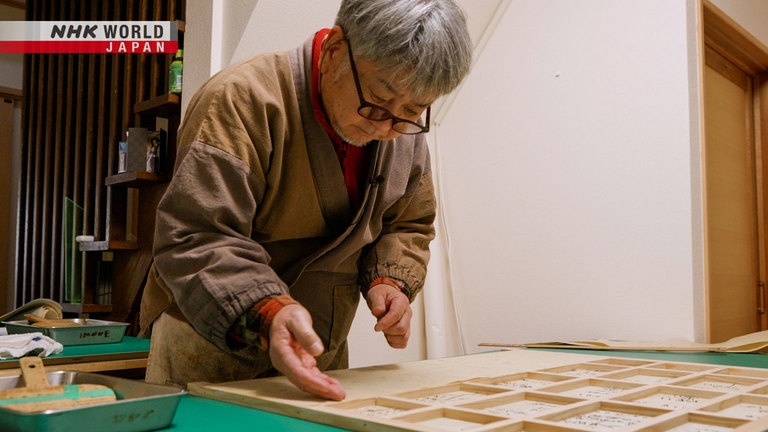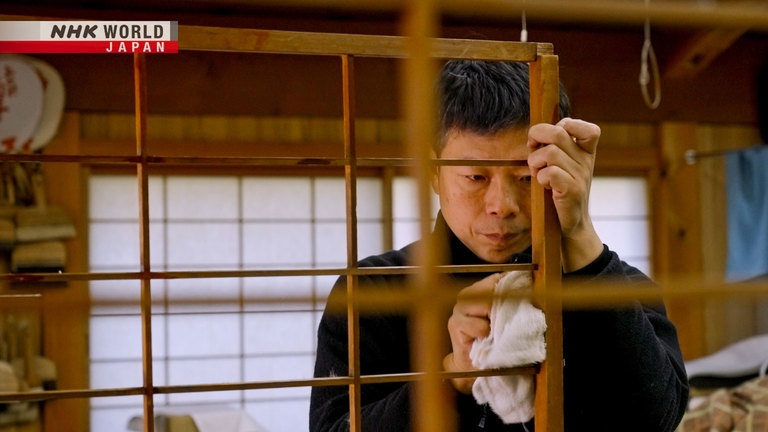Mounting Techniques: The Masters of Refined Presentation and Rejuvenation
Paintings and calligraphy are often mounted on sliding doors and scrolls. Artisans consider the story behind each piece and the client's wishes to best showcase the artwork.




Transcript
An artist pushes herself to meet a deadline.
But the painting will not be ready for viewing until it is mounted.
Patches of fabric, "washi" paper, and other materials are used to bring out and complement paintings.
This is "hyogu," or mounting, an art perfected in Kyoto.
A "hyogu" artisan specializes in mounting hanging scrolls, folding screens,
and other furnishings often seen in rooms with traditional interiors.
In Kyoto, many examples of mounted pieces that suit modern living environments
are displayed in art museums and galleries.
I think mounting is like fashion,
suiting the mood of the times.
Breathing new life into antique art is also the job of a "hyogu" artisan.
They use methods handed down over generations
to ensure the pieces will survive another century or more.
I feel my role is to pass on the things
my elders handed down to me.
Decorating, restoring, creating - the work of "hyogu" artisans is diverse.
Core Kyoto looks at the artisans who play a supporting role behind the scenes of Japanese culture.
The art of "hyogu" arrived from the Asian mainland with Buddhism in the 6th century in the form of sutra scrolls.
It further evolved with the needs and desires of the aristocracy, samurai, and tea masters.
A heritage Kyoto restaurant in Saga-Arashiyama.
Nakajima Takumi has taken on the job of repapering the "shouji" sliding doors and walls before the new year.
The owners are particular about the restaurant's interior and consider it integral to their hospitality.
Nakajima will revamp the "shouji" at his workshop.
It's in good shape.
It's dented and dirty from where
customers have bumped it.
This is used in the entrance.
The way water is used is critical in mounting.
Applying water to old paper makes it easier to remove.
One of the main jobs for "hyogu" artisans involves refurbishing old items.
Nakajima's workshop has been in business for over 90 years.
The Urasenke school of tea, which continues the legacy of grand tea master Sen no Rikyuu,
also entrusts him with the interiors of its tea rooms.
Two kinds of glue are used to repaper "shouji."
The glue which sticks the paper to the wooden frame has relatively weak adhesiveness.
The other, used to glue paper to paper, has strong adhesiveness.
The first sheet is applied.
Seams are hidden behind the wooden frame.
Strong glue is never used on the frame.
When next the "shouji" need redoing,
the weaker glue can be moistened with water and the paper easily removed.
The wisdom and ingenuity of generations of artisans are alive within the craft.
Nakajima carries on the tradition,
which he feels strongly regarding his mission as the fourth-generation owner.
I never mention it
to my kids,
but I work to keep the craft alive
in case they one day want to take over.
The majority of clientele to this Japanese antique art gallery are from abroad.
The owner, American Robert Mangold, worked as a carpenter in Kyoto,
and was impressed with the devotion Japanese artisans put into their work.
Inoue-san.
This is what I have.
- It's actually quite old.
- It sure is.
- The gold leaf adds ambiance.
- It does.
Mangold has worked with "hyogu" artisan Inoue Toshihiko for the last 20 years.
Most of the antiques he handles have been restored by Inoue.
Mangold estimates that this folding screen is possibly three centuries old.
Inoue begins restoration work.
What he has discovered are letters, ledgers, jottings, and doodles in ink.
Before Western paper, "washi" paper was such a valuable commodity, it was recycled.
They've hardly deteriorated, because
they've been inside the screen all this time.
Look closely and you'll see
the mulberry tree fibers in the washi.
These intertwine, and this is said
to make washi sturdy.
They are still entwined.
Paper mulberry fibers are straw-like and store air.
Loosely layering the "washi" as if it were floating traps air between the paper
and protects the front picture from humidity.
Inoue puts aside "washi" that can be reused.
He had a joiner make a new frame to which he adheres old paper from his stock.
This secures the framework.
Inoue applies glue between the frame's supports and layers another piece of paper.
This lessens the impact on the front picture if, by chance, the frame warps.
He continues, like this, applying three pieces of "washi" on top of the base layer.
The entire frame is covered
in three layers of paper.
They're not stuck together,
but have a layer of air in between,
so the air and moisture
are sucked in and out.
It's superb wisdom.
He now layers the "washi" he found in the old screen.
Nakajima has brought back the repapered "shouji" doors to the traditional restaurant.
And he now starts papering the freshly re-coated daub walls.
He mixes a wheat flour-based glue with a seaweed-based glue.
Water is key.
As he works, he keeps in mind the fact that the walls will need to be redone in the future.
I want to make the glue
as runny as possible.
It's no problem as long as it's thin.
The restaurant owners are partial to a graceful green "washi."
First, Nakajima moistens and stretches it.
After it has been left to sit for a while, he spreads the glue completely over the paper.
He takes his time as he coats the pieces of paper with water and glue,
then adheres them to the walls.
The walls are papered at floor level to avoid damaging or staining them when cleaning the rooms.
The wallpaper seam is fixed at around nine millimeters of overlap.
The beauty of traditional homes would be lacking without a "hyogu" artisan's finishing touch.
Nakajima works closely with carpenters and plasterers to ensure his interiors are contemporary.
At this new branch of an established Uji tea shop,
he used his artisanal sensibilities to great effect to create this countertop inspired by the Uji River,
which flows through the tea growing area.
I use the techniques my master taught me
and give them a modern twist.
It's a good introduction for youths today to know
that it is possible to use "hyogu" in new ways.
Nakajima is tireless in his efforts to make more people aware of "hyogu" in the hope that his craft lives on.
Four small pieces of "washi."
These thin, sturdy pieces of paper, which are pivotal for folding screens,
are fashioned using a papermaking method that entails repeatedly scooping and shaking a pulp mixture.
There is no record of who conceived this technique and where,
but "hyogu" artisans have been using it for at least the last 400 years.
Before the advent of hinges created from "washi,"
separate screens would be tied together with cord.
With "washi" hinges, multiple screens could be connected to depict large, flat works of art.
"Washi" hinges made a great impact on the world of art in Japan,
allowing artists to be bolder with their compositions.
When I think that "hyogu" masters I've never
met did such grand and precise work,
it makes me realize that future artisans
may well view my work the same way.
That spurs me to do
the best I can.
The folding screen has been restored.
Nice.
It has an old
and handmade feel.
I like the gold leaf.
With Inoue's assistance, the folding screen is ready to start a new life abroad.
Well, I think that in, ah, obviously,
I mean Japan has a, a reverence for "hyogu" all around the country.
But there is a significant reverence for the "hyogu" of Kyoto.
I mean no matter where you go,
I mean, it has its own term; it's Kyoto "hyogu."
It's not just "hyogu."
A "hyogu" exhibition, with a history of over a century, is held annually in Kyoto.
The 2023 exhibition featured 80 calligraphic works and paintings.
At one time, over 120 pieces were displayed.
In the past, people would hang scrolls
in their alcoves and admire them.
Fewer homes today have alcoves
due to Japan's modern housing styles,
so the need for hanging scrolls
has dropped.
The exhibition also includes numerous unorthodox-looking scrolls.
The calligraphy, subject matter of the paintings,
and background fabric color and patterns make them distinctive.
Murayama Hideki, originally from Tokyo,
took over his father-in-law's Kyoto "hyogu" business as the third-generation artisan.
He aspires to producing mounting that is contemporary.
We use the same methods,
but the generation of people buying
and using our services has changed.
Their abodes and walls are different,
so we "hyogu" artisans have to
take that into consideration.
On this day, an emerging painter came to see how Murayama had mounted her work.
- It's good.
- So?
It's great.
The colors match well.
Murayama mounted this delicate painting of a flower on a thin plank of Japanese thuja wood to look like a scroll.
It's superb.
Artist Mori Yuka has made Kyoto her base.
Three years ago, she began entrusting Murayama with her paintings.
Mori has received a commission from a Kyoto gallery for a painting
that would be suitable to display during the new year celebrations.
She wants Murayama to mount it.
He chooses the right fabrics
to match the works,
like he's coordinating my outfit.
He's like a reliable stylist —
who can tell me how to wear
my clothes and suggest accessories.
Mori's new painting is ready for Murayama to mount.
- Here we go.
- Ready.
Ta-da!
It's excellent.
It's fun. The Seven Lucky Gods.
It's a brilliant painting.
Really?
- Bats.
- Cute.
They're really bats?
- Wow.
- Nice, right?
Auspicious figured satin.
But this doesn't suit the painting.
Nor this.
Shall I hold something?
"Hyogu" probably came from China
with Buddhism, such as scrolls.
They aged or were damaged and needed
repairing. That evolved into the "hyogu" craft.
I was glad to hear Mori say it is like
choosing clothes together.
I'm blessed to collaborate
like this.
Murayama will mount Mori's painting on a scroll.
First, he applies about three millimeters of glue to the left and right sides.
He adheres a piece of "washi" about six millimeters wide to attach the picture to the fabric.
Following this, he glues the fabric onto the tab.
This aligns the edge of the painting with the fabric's surface.
The same fabric is used at the top and bottom of the painting.
Here's the basic form.
Now to reinforce the border between the painting and the fabric on the back.
This thin "washi" strip prevents the painting from curving when it is rolled up.
Next, Murayama attaches the roller rod.
The left and right sides must be perfectly aligned.
Last, he attaches the hanging cord.
Done.
Mori and Murayama deliver the scroll.
It's the Seven Lucky Gods.
I'll let go.
It's brilliant and fun.
This is the most colors
I've used in one painting.
I wanted it to be celebratory.
I like how it sticks out.
The roller knobs, called champers,
are unusual.
They have a red tinge, which is nice
and matches the painting.
Murayama always
does a good job.
Is that the rising sun?
Is it embroidered?
I used gold leaf, so it wouldn't
be too obvious.
Nice effect.
If the fabric was darker,
the gold would be too much.
The painting is quite unconventional,
and the mounting brings it together
and lends it grace.
Tradition can be passed on
using only established techniques.
I think it's changing methods a little
to create something to suit the times.
"Hyogu" is not something staid
to be admired in a formal setting.
It's something incorporating
the seasons or flowers into daily life.
It'd please me to see people think of it
as they would casual clothing.
Inherited skills and artisanal spirit transcend time.
Kyoto "hyogu" complements and embellishes tradition.